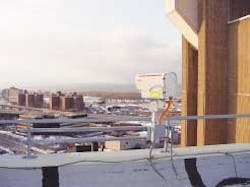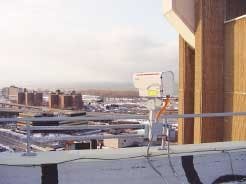Second time is the charm for FSO
The New York State Unified Court System represents one example of repeat business. As reported previously in Lightwave, the court system first turned to FSO in the wake of the terrorist attacks on the World Trade Center (see Lightwave, February 2002, page 1). Three FSO systems, hurriedly installed beginning the weekend following the collapse of the Twin Towers, helped restore services to Manhattan courts in less than a week.
The experience has led Sheng Guo, chief technology officer, Division of Technology, Office of Court Administration for the Unified Court System, to incorporate FSO as a regular infrastructure option. "Wherever possible, if cost-effective, we want to build using landline fiber," he says in discussing high-bandwidth applications. "However, sometimes the cost is too high or it's too time-consuming, and we've found that free-space optics is a better solution."
For example, the court system is building a pair of optical rings—actually, triangles—in the Bronx and in the Jamaica section of Queens; in each case, three court buildings that are not equidistant will be linked. Guo has used fiber for the shorter sides of the two triangles. However, he estimates that closing the triangles via fiber on the longest runs could cost as much as $200,000 each and would involve building permits, engineering reviews, and other time-consuming bureaucracy. Conversely, completing the triangles with FSO cost $40,000 each and required much less time.
Similarly, the court system has installed an FSO link in White Plains, NY, between a courthouse and a nearby judicial institute. In the reverse of common practice, Guo will use a T1 landline as a backup to the optical system, because with the FSO equipment "you can get something better than a T1." He investigated upgrading the T1 landline to DS-3; that option would have cost him $30,000 a year. The FSO option supported 100-Mbit/sec Fast Ethernet, which compares favorably to the 45 Mbits/sec of the DS-3; its $40,000 installed cost would be repaid in about 15 months. "So I think it's a good deal," he concludes.
FSO also has found use as an upgrade of conventional wireless links. In Suffolk County, Long Island, a 1-Gbit/sec system will replace an RF connection whose 11 Mbits/sec no longer met user requirements. Finally, the technology continues to prove useful in emergency situations, as proven when a carrier upon which the court system relied for backbone services in upstate New York went bankrupt. Guo used an FSO system to link facilities in Buffalo, Rochester, and Syracuse to a private network operated by the state government until a new service provider could be found.
Guo has remained with his initial equipment provider, the Broadcast and Communications Division of Canon USA (Lake Success, NY), throughout his FSO expansion. The company supplies two FSO models to the New York court system: the 622-Mbit/sec Canobeam DT-50 and 1-Gbit/sec DT-55. While the latter supplies more bandwidth and supports Gigabit Ethernet, the former supports longer link distances. Therefore, Guo says that once he decides to install an FSO link, he finds himself balancing bandwidth and distance when he chooses a system. In all cases, he remains well within the specifications Canon offers.
"We only pick the GigE if the buildings aren't that far away, like 1,000 m. So everything is below the spec," Guo explains. "So if the spec says you can go to 2,000 m, we won't go the 2,000. We'll be conservative. So maybe we'll go 1,000 m."
Ken Ito, assistant director at Canon USA's Broadcast and Communications Division, lauds this approach. "Technically, they've been very willing to learn what the technology can do and what has been done before. They have never really stretched it out of the limits of what we recommend," he says. "If you try to stretch the limits of what the technology can do, obviously, you're not going to be happy with the results that you find. And they've really used the technology in the right way, and that's why I believe they're so happy with it and why they've found it so useful."
Ito says that link distances vary by application, with prevailing weather conditions one of the more significant determining factors. As a rule of thumb, Canon's systems can generally support distances twice as far the eye can see, with the DT-50 topping out at 2 km and DT-55 at 1 km.
With budgets tight in the New York State Unified Court System, Guo must justify any major communications expense. That leads him to weigh carefully system cost, potential recoup of installation expenses, application requirements, and the number of users who will benefit from the new communications link when evaluating his options. Like most network managers, he finds bandwidth demands rising steadily—although in some cases for uncommon reasons.
For example, the recently issued National Strategy for Homeland Security calls for heightened surveillance in courthouses. That means the installation of a video surveillance network. Since each camera can consume 8-10 Mbits/sec of bandwidth—significantly more than a T1 can provide—high-capacity links have become a more ubiquitous requirement. So FSO promises to become a mainstay of the court system's infrastructure.

